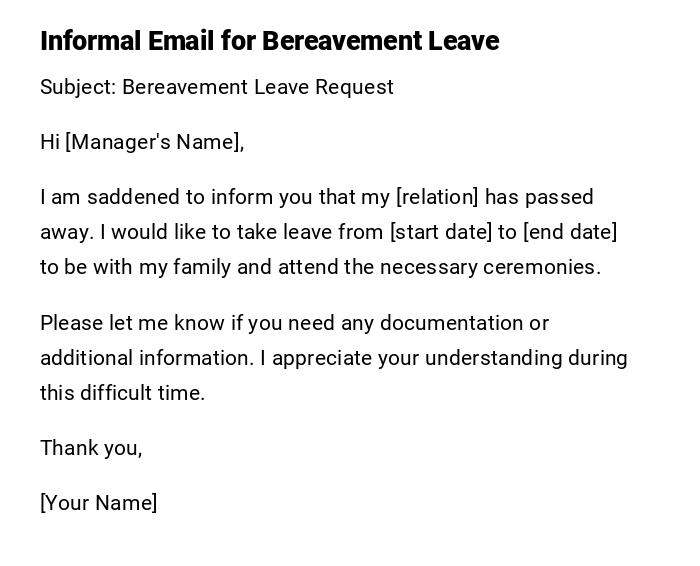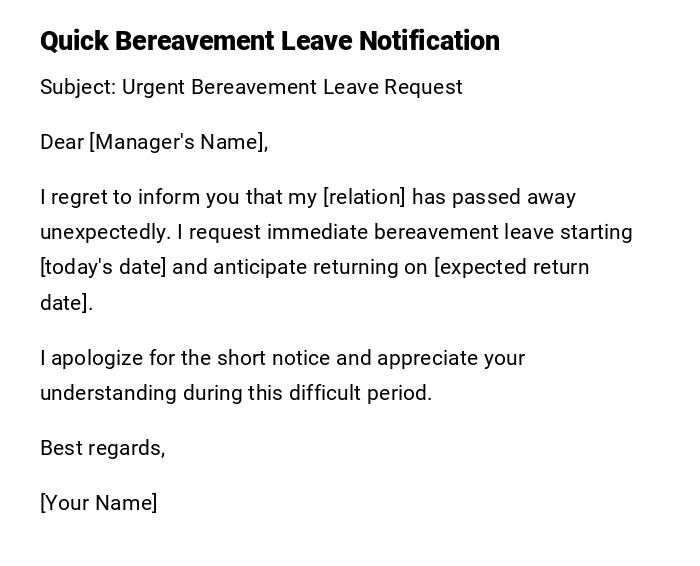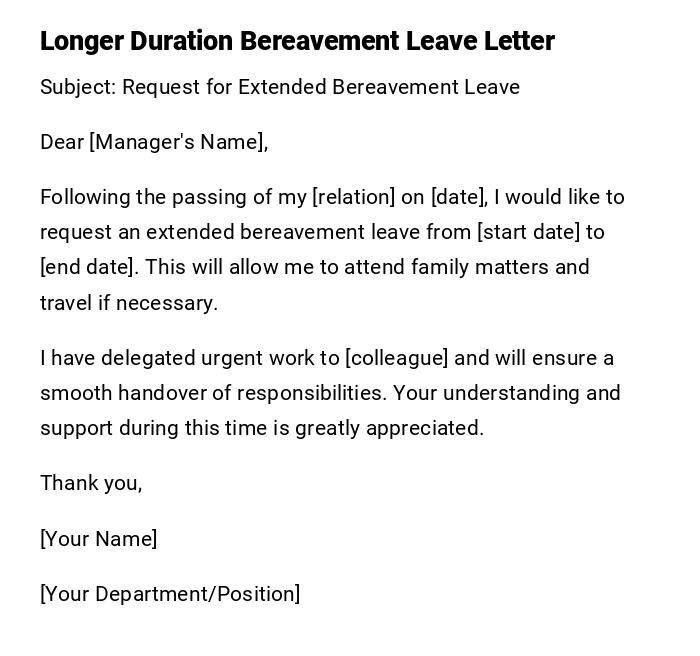Bereavement Leave Letter
Dear [Recipient's Name],
I hope this letter finds you well. I am writing to formally request a period of bereavement leave following the recent passing of a close family member. I am deeply saddened by this loss, and I require time to grieve, attend necessary arrangements, and support my family during this difficult time.
I would like to inform you that the family member who has passed away is [Name of deceased] and their relationship to me was [e.g., parent, grandparent, sibling]. The funeral service is scheduled for [Date] at [Location], and I will need to be present to fulfill my responsibilities and provide emotional support to my family.
I kindly request a bereavement leave starting from [Date] and lasting for approximately [Number of days] days. I understand that the company's policy may require additional documentation, and I am prepared to provide the necessary evidence, such as an obituary or funeral program, to support my request.
During my absence, I am confident that my colleagues will be able to handle my workload effectively. I am willing to delegate my tasks and responsibilities or provide any necessary instructions to ensure a smooth transition during my leave. If there are any urgent matters that require immediate attention, please do not hesitate to contact me via email or phone, and I will respond promptly.
I am grateful for your understanding and support during this challenging time. I have always appreciated the supportive work environment we have at [Company/Organization Name], and I am confident that my colleagues will provide the necessary support to help me through this period.
Please let me know if there is any additional information or documentation required from my end to process this request. I will be more than willing to fulfill any necessary obligations. I would appreciate receiving a written confirmation of my bereavement leave request once it has been approved, outlining the start and end dates of my leave.
Thank you for your attention and consideration. I look forward to your prompt response.
Yours sincerely,
[Your Name]
Formal Bereavement Leave Letter
Subject: Request for Bereavement Leave
Dear [Manager's Name],
I am writing to formally request bereavement leave due to the passing of my [relation, e.g., father, mother, spouse] on [date]. I would like to request leave from [start date] to [end date].
During this period, I will ensure that all urgent tasks are handed over to [colleague's name] to maintain workflow continuity. I would appreciate your understanding and approval.
Thank you for your consideration.
Sincerely,
[Your Name]
[Your Position]
Casual Bereavement Leave Email
Subject: Bereavement Leave Request
Hi [Manager's Name],
I am saddened to inform you that my [relation] has passed away. I would like to take leave from [start date] to [end date] to be with my family and attend the necessary ceremonies.
Please let me know if you need any documentation or additional information. I appreciate your understanding during this difficult time.
Thank you,
[Your Name]
Bereavement Leave Letter for HR Documentation
Subject: Bereavement Leave Notification
Dear HR Team,
I wish to inform you of my need to take bereavement leave following the passing of my [relation] on [date]. I request leave from [start date] to [end date] and would appreciate the necessary formalities being processed.
Attached are the supporting documents including the death certificate for your records.
Sincerely,
[Your Name]
[Employee ID]
Short Notice Bereavement Leave Letter
Subject: Urgent Bereavement Leave Request
Dear [Manager's Name],
I regret to inform you that my [relation] has passed away unexpectedly. I request immediate bereavement leave starting [today's date] and anticipate returning on [expected return date].
I apologize for the short notice and appreciate your understanding during this difficult period.
Best regards,
[Your Name]
Extended Bereavement Leave Request Letter
Subject: Request for Extended Bereavement Leave
Dear [Manager's Name],
Following the passing of my [relation] on [date], I would like to request an extended bereavement leave from [start date] to [end date]. This will allow me to attend family matters and travel if necessary.
I have delegated urgent work to [colleague] and will ensure a smooth handover of responsibilities. Your understanding and support during this time is greatly appreciated.
Thank you,
[Your Name]
[Your Department/Position]
What / Why You Need a Bereavement Leave Letter
Purpose and Importance of Bereavement Leave Letter
- A formal request to an employer or HR department for time off due to the death of a close family member.
- Purpose:
- Allows employees to grieve and attend funeral or memorial services.
- Provides official documentation for payroll and HR records.
- Ensures work responsibilities are managed in the employee's absence.
- Maintains professional communication with supervisors and colleagues.
Who Should Send a Bereavement Leave Letter
Authorized Senders
- Employees who have experienced the loss of a family member.
- Staff requiring official leave for personal bereavement.
- Individuals responsible for informing HR or management of their absence.
Whom Should Receive a Bereavement Leave Letter
Recipients
- Immediate supervisors or managers for approval.
- Human Resources department for official record-keeping.
- Payroll or administrative departments if leave affects salary or benefits.
When to Send a Bereavement Leave Letter
Timing Considerations
- Immediately upon the occurrence of a family member's death.
- Before the funeral or memorial services when possible.
- As soon as feasible for HR documentation and payroll adjustments.
- For planned extended travel related to bereavement.
How to Write and Send a Bereavement Leave Letter
Process
- Begin with a clear subject line such as "Bereavement Leave Request".
- Include relation of the deceased, date of death, and requested leave duration.
- Provide any supporting documents if required (e.g., death certificate).
- Use a professional tone for official letters, or a compassionate informal tone for email communication.
- Send via email for urgent notice, or printed letter if formal documentation is required.
Formatting Guidelines for Bereavement Leave Letters
Style and Structure
- Length: Concise, usually half to one page.
- Tone: Polite, respectful, and empathetic.
- Structure: Subject, greeting, statement of bereavement, requested leave dates, closing, signature.
- Attachments: Death certificate or other proof when necessary.
- Mode: Email for quick notification; printed letter for HR records.
Tricks and Tips for Bereavement Leave Letters
Best Practices
- Keep the message respectful and concise.
- Specify exact leave dates to avoid confusion.
- Notify your manager as soon as possible, even by phone, and follow up with the letter.
- Delegate urgent work if feasible before leave starts.
- Attach necessary documentation for HR verification.
Common Mistakes in Bereavement Leave Letters
Mistakes to Avoid
- Failing to include the relationship to the deceased.
- Not stating leave start and end dates.
- Omitting HR or manager as recipients.
- Using overly casual or inappropriate language.
- Neglecting to attach required documents for formal records.
Elements and Structure of a Bereavement Leave Letter
Key Components
- Subject line: Bereavement Leave Request.
- Salutation addressing manager or HR.
- Statement of bereavement and relationship to the deceased.
- Requested leave duration with start and end dates.
- Optional explanation of urgent work coverage.
- Attachments: proof of bereavement if needed.
- Closing with signature and contact details.
After Sending a Bereavement Leave Letter
Follow-Up Steps
- Confirm receipt with HR or manager.
- Ensure leave is approved in HR system or leave tracker.
- Maintain copies of the letter for personal and payroll records.
- Communicate return date and reassignments to team members if needed.
Pros and Cons of Sending a Bereavement Leave Letter
Advantages
- Provides official documentation for leave approval.
- Demonstrates professionalism and courtesy during sensitive times.
- Ensures smooth workflow management in your absence.
Disadvantages
- May feel emotionally challenging to write immediately after loss.
- Requires attention to correct recipients and supporting documentation.







 Download Word Doc
Download Word Doc
 Download PDF
Download PDF